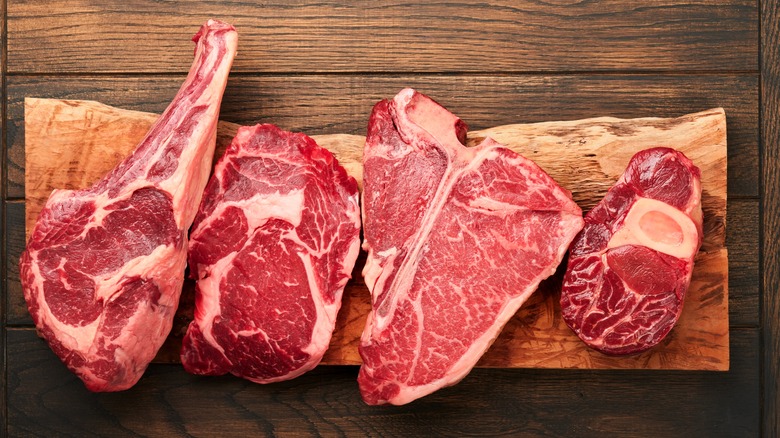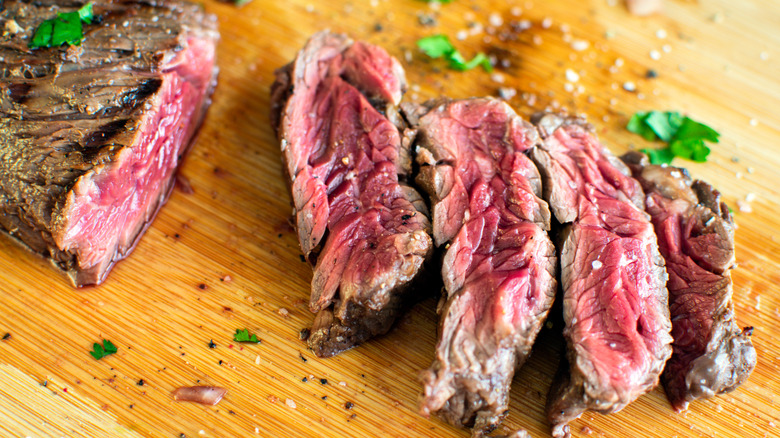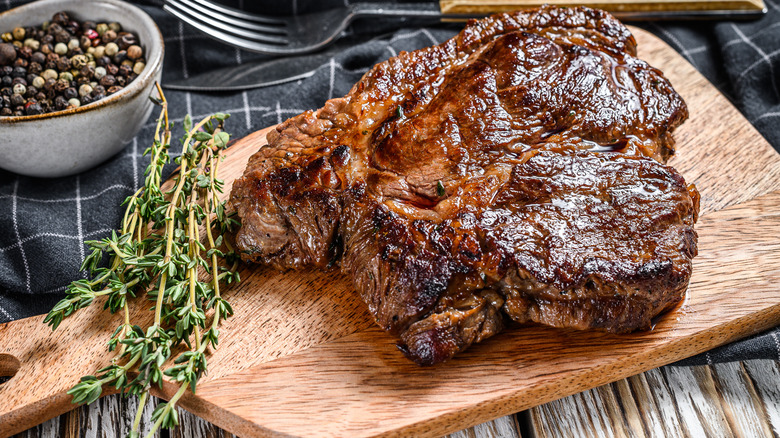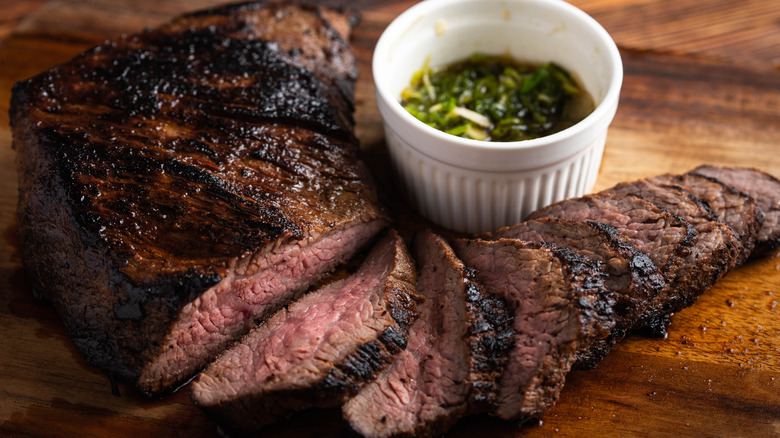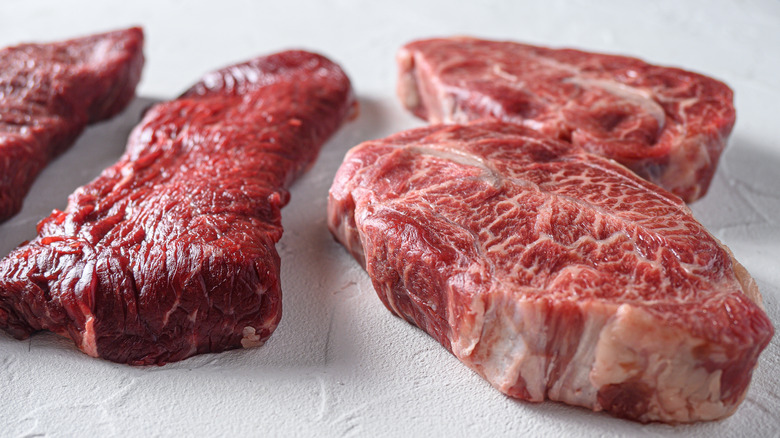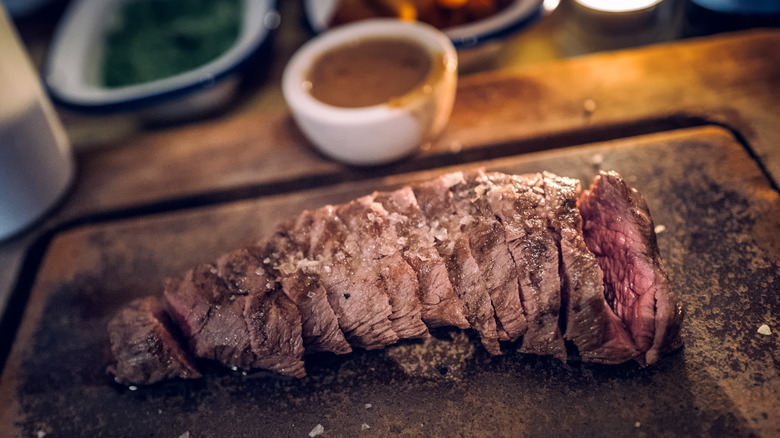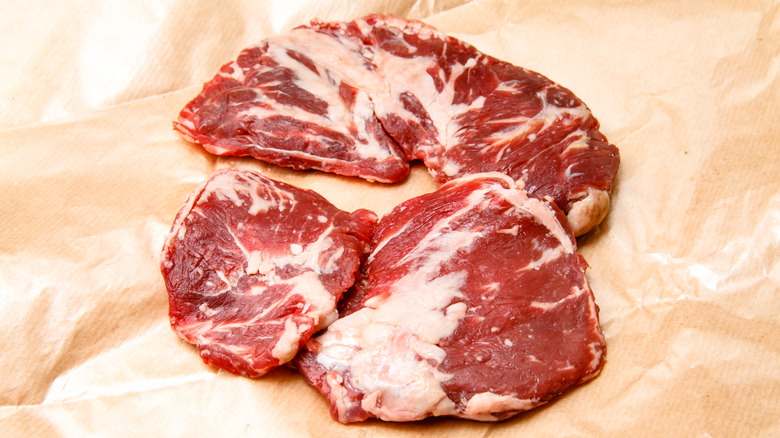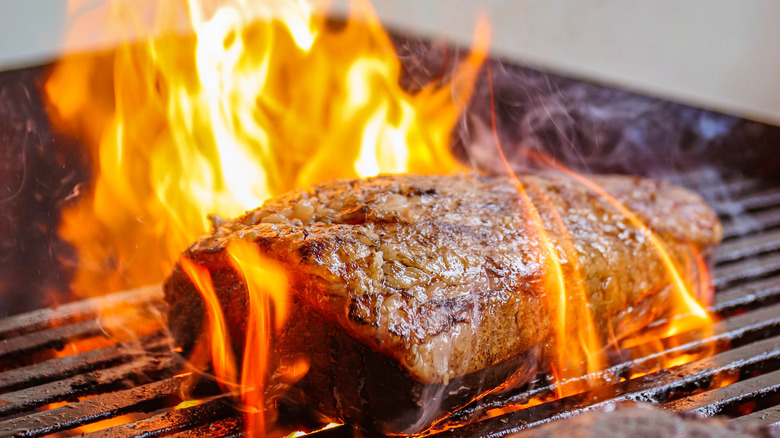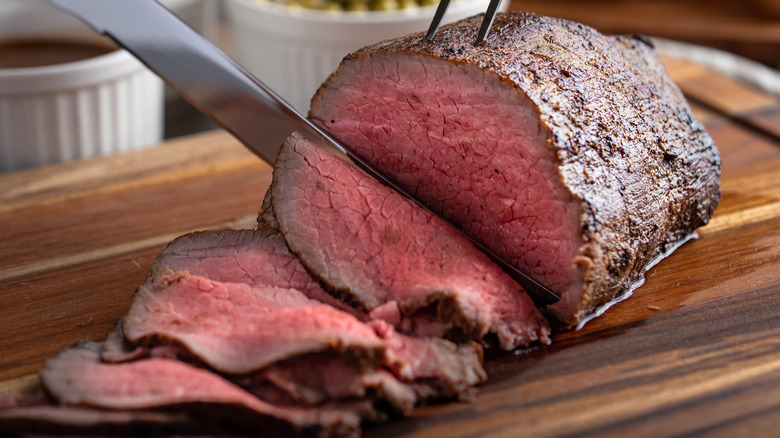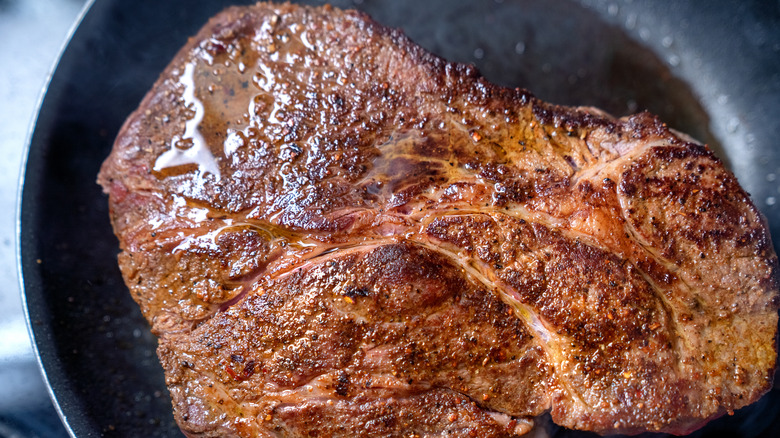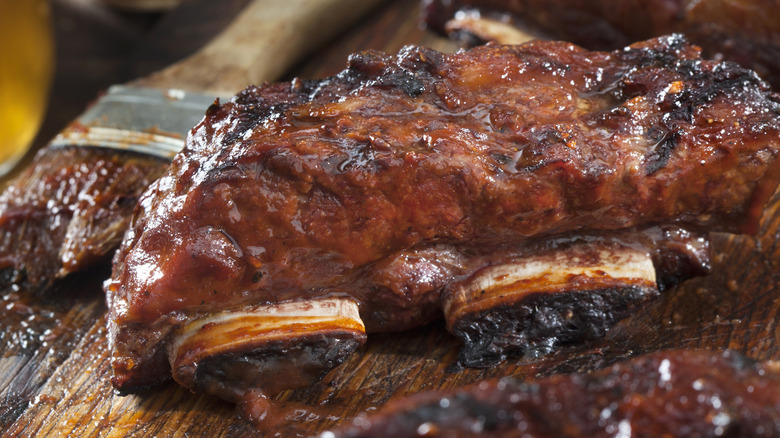Underrated Cuts Of Steak You Need To Try
Nothing makes a meal or a date stand out like an impressive steak. While ordering at restaurants is as easy as saying "medium-rare," if you're ready to fire up the grill yourself, there are a whole lot more options to consider. Before you decide whether to grill or roast, have mashed potatoes or greens on the side, or pair with a malbec or cabernet sauvignon, you'll need to decide which cut is right for you.
That's easier said than done. Down to the same cow, not all cuts are created equal, and you'll get a blank stare from your local butcher if you just ask for "steak." Even for affordable cuts, the wrong choice can be costly. On average, steak is much more expensive per pound than pork and poultry.
Prized cuts like Japanese Kobe and filet mignon might ring a bell, but they'll also break the bank. Typically, each variety of cut has a preparation method that it is best suited for. Some cuts are naturally rich in sought-after qualities like marbling and tenderness and are delectable with little effort. Steaks which are underrated have great potential but require a little extra work. Underrated cuts are cheaper, and the better you prepare your cut, the more bang you get for your buck. Likewise, You can burn filet mignon just as well as a two-buck-chuck. To avoid a kitchen nightmare, here are a few underrated, affordable, great-tasting options to expand your palate.
Hanger steak
Hanger steak was once a cut that insiders agreed didn't get its roses. That was until the 21st century. Now "onglet" cuts as it is delightfully called by the French can hardly make this list. Hanger steak is well-marbled and one of the most tender cuts of steak on the cow. It's a flavorful, and rich cut known as the "butcher's steak" because butchers traditionally took it home for themselves. It's not highly sought after but it is rare, so it's still a cut you'll find most easily at a local butcher.
While there's a chewy membrane that runs down the center, it can be easily removed. The real problem is it is a smaller, thin cut and cows only have one of them. Limited supply makes them a more boutique product and supermarkets often don't carry them.
For hanger steak, the quality is all in the preparation. Before throwing it on the grill, letting the meat marinate will ensure you get the most flavor out of your steak. An acidic marinade, citrus-based for example, will keep the meat tender. In practical terms, that means a steak that melts in your mouth. A good marinade will also enhance the rich flavor found in the nutrient-packed cut. Cook this thin cut briefly over high heat and you have a juicy, tender steak. Throw in bold spices and chimichurri to make amazing homemade steak tacos, keep leftovers for steak salad, or just savor the knowledge of knowing this underrated steak.
Chuck
Chuck is an affordable alternative to the prized ribeye cut and is ideal for stews, pot roasts, and slow cookers. ALthough the chuck comes from the shoulder, a muscular part of the cow that is tougher than the average cut, the ribeye comes from the center cut of the rib steak, hence the term "eye."
Coming from a cow's strong neck and shoulder muscles, chucks are very chewy on their own. However, if prepared with a marinade, as a stew, or slow-braised, the cut will become tender, savory, and rich.
Marinade will be a theme with these cuts. More popular, though properly rated, steaks come from less muscular parts of the cow and have a natural tenderness due to their leisurely lives. The acid in marinades not only complicates the flavor but also breaks down those muscular proteins. Before adding your stew ingredients brown both sides of the steak in a pan. Then braise slowly in broth with spices, root vegetables like carrots and potatoes, and add traditional steak herbs like rosemary for a rich winter meal. The carrots and potatoes should be soft and soaked in juicy broth and the meat will become so tender it will fall apart in your mouth. Your efforts will yield a lot of food that freezes well.
Packing a lot of meat while being affordable, chuck stews are a great freeze-for-later candidate. Note, though it's good in a stew, chuck steak is not what is packaged as stew meat! There's no telling what part of the cow that brownish meat comes from.
Tri-tip
Familiar to California foodies, tri-tip steak is still underrated outside the Golden State. No, it doesn't come from three-headed cows; the word tri refers to its triangle shape cut from the bottom sirloin.
Tri-tip was long relegated to the butcher's sidelines, used as ground beef until it caught on in the 1950s. While other cuts have more natural flavor, the tri-tip can be a blank slate for experimenting with pairings and seasonings. The cut has minimal fat or connective tissue, making it a healthy and fuss-free choice. It takes on a mouth-watering smokiness when cooked on the grill or over an open-pit fire as California BBQers do it.
It's a lean cut, often referred to as the "California cut" and a substitute for prime rib. It has about the same thickness as pork loin, with beefy flavor goodness.
For the burgeoning pit master, coat the meat with a generous smattering of salt, pepper, garlic, or paprika to make your own BBQ bark. Tri-tip is also delicious on the pan, grilled or oven-roasted. Its versatility and affordability make it a great option for everyone from beginners to experienced experimenters. Plus, its thick end tapers to thin from one end to the other, meaning the same cut can satisfy different temperature preferences, another date-saver. For a dry rub add plenty of garlic and onion powder and a splash of cumin. Or, with the summer coming within reach, fire up the grill for this tri-tip recipe with corn salsa.
Sirloin bavette
Is skirt steak too mainstream for you? Try a thick and tender alternative. Bavette comes from the French word for bib, but it looks like one of those frilly Renaissance collars.
Popularized by French butchers, sirloin bavette is an affordable and delicious alternative to hanger and skirt steak and comes from the cow's abdomen in the bottom sirloin. Part of its bavette's overlooked rep is due to inconsistent brand identity — it is also called the flap, faux hanger, sirloin tip, or any iteration of those words. And if that doesn't work, ask for the bottom sirloin.
If you don't mind going on a bit of a texture adventure, bavette cuts offer a fantastic flavor at a larger portion and lower price point than skirt steaks. It's a thin cut, so marinating will produce a robust flavor while compensating for the meat's relative lack of tenderness. If you're a firm believer that in a high sauce-to-steak ratio, thinner cuts like hanger and bavette might be a good choice.
Cook to medium rare on the grill or in the skillet, and you'll have a flavorful, thin cut perfect for sandwiches or fajitas. After you've left it to rest for your obligatory five minutes, cut across the grain to break up its muscle fibers. Doing that for any cut of steak will help make the steak less chewy. Don't skimp on a great steak sauce, either.
Flat iron
Hiding behind a bit of sinewy tissue in the top blade roast, the cow's shoulder (part of the generally overlooked chuck) is a tender, nicely marbled, intensely beefy cut: flat iron steak.
Flat iron is one of the more nicely marbled cuts on this list, so cook on high heat to melt as much of the fat as possible. Flat iron is less muscular than its tough, muscular neighbor, chuck, so you have more options in terms of dishes and preperation. Flat iron is tender all on its own, so it's great on the grill and skillet. Keep in mind that a thin cut will also cook more evenly, though it's still best to practice responsible temperature distribution. Let the steak reach room temperature, pre-heat your pan, and rotate often. To that end, make sure you have a meat thermometer (for flat iron and all steak). Chefs can eyeball temperature, but home cooks should avoid that mistake.
After cooking, wrap in tin foil and let rest for about five minutes. Letting the meat rest will allow the juices that rose to the surface during cooking to soak back into the meat. Another item from the notebook dump: cutting any steak just after taking it off the grill will waste precious flavor.
Spider cut
If you ignore the unfortunate marketing, spider cuts can be delicious and dexterous. From the shoulder blade (or blade roast) of the cow, it has a lean, balanced profile and a web-like tissue running through the center of the cut — hence the "spider" name. The meat itself is shaped like an oyster and may also be called an oyster cut, though I'm not sure if I see it. I'm even less sure about the "Pope's Eye" as it's sometimes known in England.
Regardless, the meat is tender and flavorful, even beefy for beef. Preparation needs to account for the tough texture of the strong neck muscle. Make sure to marinate, cook low and slow, and monitor the temperature. Otherwise, you'll have a chewy, tough steak in addition to the sinew, marbling's evil twin.
Cook the cut to medium rare or medium. As with Flat Iron, be sure to monitor the temp closely so as not to overcook it, though spider steak doesn't have the tasty fatty marbling that flat iron does. You can slice the meat into cubes, adding cilantro to balance the beefiness, then cumin, chili powder, lime, and bell peppers to craft your own carne asada Chipotle burrito or steak sandwich. This cut is unique and flavorful, and you get to tell your guests: "Spider's on the grill, get your plates!"
Culotte steak
Also known as "top sirloin cap" coulotte cuts are lean cuts of beef perfect for the grill. That's because one side is covered with a thin layer of fat that when melted turns this cut into a moist and juicy piece of steak. It's a unique aspect of the cut which offers a lot of room for creativity in your preparation. Coulotte is popular in Brazil, well known for its steakhouses. In Brazil, "pincaha" is lopped right off the shawarma-style vertical grilling skewers.
Practice your grill skills with vigilance to make the most of this underrated cut. Make sure you know the grill temperature too: if it's too low the meat may stick to the grill. Plus, a hotter grill makes for those beautiful burn marks. This is a relatively thin cut, so make sure not to overcook it., and please, use a meat thermometer. Don't eyeball the temperature — leave that to chefs.
What really makes this cut shine is a marinade. Cover that fatty layer with herbs and spices for flavor, butter for fat, and acid to break down protein fibers. Acid softens the meat giving steak that melt-in-your-mouth finish. Oil seals in moisture, especially important to lock in the juicy flavor for this cut.
For bonus grill points, use a charcoal grill with Coulotte cuts. Charcoal burns hotter which is necessary for the Maillard effect. Not only will the fatty layer melt into the meat but it will caramelize beautifully on the inside and out.
Tender rump roast
You know roast beef, but probably not the cut it comes from. Tender rump roast comes from the round, the rear end of the cow. The name itself is enough to drive down the price but if prepared well, this cut has an amazing flavor secret and makes a traditional holiday dish or endless sandwiches.
Rump roast presents some challenges to the uninitiated. It's lean, so it can easily dry out. There's little marbling to it either. Plus, cows have big butts, so this is a massive cut of meat. It's about four pounds, tall and round, so while you can cook it on the stovetop, it's far more practical to let the oven do the work. Cooking the meat alone takes about an hour on heat, but that slow heat will yield a tender and juicy finished product that is rich in glorious beefy flavor.
Tender rump roast has layers, too, like a steak onion. Before putting it in the oven, sear the beef on the stovetop. That gives you a beautiful, spiced caramelized crust on the outside. With the help of butter and acid, low and slow cooking breaks down the protein and tissue on the inside. Plus, its excess juice is perfect for dipping the roast beef sandwiches you will inevitably make from all the leftovers. From Christmas pot roast to Jewish deli roast beef, this is a tender rump we can all get behind.
Chuck arm roast
Chuck arm roast is another cut of the neck and shoulder area. Like the chuck roast, it requires vigilance to prepare, but braised or cooked slowly, the chuck arm roast is naturally savory and more tender than the chuck roast. Similarly to the tender rump roast, it's also a family-feeder.
The name is a bit misleading: chuck arm roast, or chuck primal, doesn't come from a cow "arm" but the shoulder. That shoulder has quite a lot of meat to carry around, a fact that is worthy of digression. The average dairy cow weighs in at 800 to 1,500 pounds when fully grown. But those are skinny compared to beef cows which can weight up to 2,500 pounds. For your edification, the largest cows are the Chianina breed which pack an average of 3,000 pounds.
The point is, that's a heavy load for a heavy shoulder. All that supporting ratchets up the protein and tissue of the chuck arm roast, likewise ratcheting up its toughness, cooking time, and work for you. This cut is another low and slow champ: rub with rosemary, thyme, paprika, and any other robust seasoning. Then, sear preemptively as with the tender rump. From there it's up to you, and by now you know with a cut that's thick and tough you can braise, stew, or even smoke. You'll end up with a ton (almost) of tender morsels. It's a lot of work, but like the cow, you'll be stronger for it.
BBQ ribs
Does it count as steak if you eat it with your hands? Yes. Set beside the popular ribeye and prime rib roasts, the back ribs are a classic staple of the wondrous arts of barbecue. Done right, ribs are all that steak can be: So tender it falls off the bone, incredibly beefy, crisply barked, and soaked in sauce. Within BBQ there is a whole world of options to tinker with. Forms of preparation vary from state to state with each domain vying for the best seasonings and sauces.
You don't have to be from Texas or even own a smoker to give BBQ beef ribs a try — you can make them at home in your oven. Soaking wet in sauce or smoked with a dry rub, there's no way to go wrong except for cooking it on the stovetop; there's no way that goes well. Start with garlic and onion powder, cracked black pepper for the dry rub, and experiment from there. To keep the moisture and natural juice from escaping while it cooks, wrap the meat in tin foil while it cooks low and slow. Once you find your magic rub mix, you can preserve it in a mason jar for future underrated cuts.
